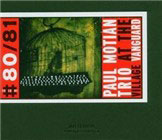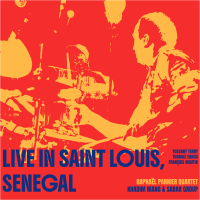Home » Jazz Articles » Profile » The Bob Parent Archive Project: A Photographer's Legacy ...
The Bob Parent Archive Project: A Photographer's Legacy Quietly Grows
Bob Parent was a New York-based photographer whose lucid, defining images appeared regularly in Life, Downbeat magazine (the "jazz bible"), in books and on album covers. He became increasingly well known, especially for his pictures of jazz musicians. He also developed ingenious ways to sidestep the use of flash in order to avoid disturbing performers. His pictures were shown in galleries, libraries and colleges.
A brain tumor felled Parent in 1987 after a busy life that had left him little time for self-promotion. His nephew, Dale Parent, manages the archive of more than 200,000 images, which continue to appear in magazines, newspapers, galleries, museums and historical institutions such as the Smithsonian.
Yet today the archive, which also contains some of the only known photographs of many civil rights events, is in serious danger.
Most of the thousands of negatives, contact sheets and transparencies are stored in mildly acidic glassine envelopes which are chemically eating away at them. Some images are already irretrievably lost. The envelopes need to be carefully replaced with chemically neutral, state-of-the-art, archival quality film storage pages, which were not available in Bob Parent's time.
The Archive also needs to be organized so that its contents are identified, documented and readily available. The artist left his archive in severe disarray. Countless negatives, transparencies and contact sheets contain images that have not been specifically identified and are almost randomly placed in the file. This chaotic jumble of crumbling storage folders conceals treasures that are being found and identified every day by Dale Parent with the help of a pair of assistants and a number of helpful jazz musicians and experts who have volunteered their time. Some recently identified photographs are of John Coltrane, Malcolm X, Mahalia Jackson and Richard Nixon.
The archive is not profitable, so there are virtually no funds available to perform the work of rescuing the archive. Dale Parent maintains the archive with volunteer assistance.
One day, the Bob Parent archive might become profitable, and there will be no need for outside funding to maintain it. That day is probably a long way away. Today, Dale Parent is essentially maintaining the archive as a labor of love, putting in an average of 30 hours a week. The archive requires grants to survive. Otherwise, in half a century, historians will have suffered an irretrievable loss.
The Life of Bob Parent
Bob Parent (1923-1987) began his career as a photographer in about 1945. From then until his death, he spent countless nights in the dimly lit jazz clubs of Boston and New York, capturing images of all the jazz greats of the post-war era, from Sidney Bechet to John Coltrane.The Canadian-born son of a sign maker, Bob Parent was one of the first photographers to regularly work inside jazz clubs. The clubs for many decades did not welcome photographers, particularly because of the disruptive flashes that were necessary in the dark conditions. Parent personally disliked flashes because he felt they could interfere with a scene in its most sensitive moments, such as in the middle of a solo. Early on, he created equipment that cast an ambient, glare-free, spreading light. By the early 1950s, he abandoned the use of flash altogether, having learned to make the most of available light.
Parent amassed an archive of over 200,000 images including some of the most definitive and well-known shots of, to name just a few: Billie Holiday, Duke Ellington, Charles Mingus, Charlie Parker, Malcolm X, Miles Davis, Ella Fitzgerald, Louis Armstrong, Fidel Castro, Che Guevara and Malcolm X. The pictures have appeared on major album covers, in jazz textbooks, in major newspapers worldwide, and in dozens of exhibitions.
Parent's subjects also include sporting events, dance, theater, artists, politicians, civil rights leaders, New York and Boston city life, New England farms and countryside, Japan under U.S. occupation, post-war Havana and the 1964 World's Fair. The Archive also contains hundreds of original clippings, correspondence, flyers and other pieces of memorabilia concerning jazz and the civil rights movement.
Besides their countless newspapers and magazine appearances, Parent's photos have been in many books on music and politics, including Jazz Is by Nat Hentoff; Celebrating Bird by Gary Giddins, and Malcolm X Speaks. He created the art and cover designs for several Charlie Parker and Duke Ellington albums, among others.
Bob Parent's career paralleled a period in American culture that witnessed some of our greatest achievements, music perhaps first among them, as well as outsized personalities from all walks of life. Parent was there to record it all. He constantly attended concerts and visited artists at their homes and studios. He paid calls on everyone from jazz artists great and small to Marcel Duchamp in his New York apartment. He attended nearly every civil rights rally in New York and Washington in the 1960s and '70s. His output is staggering: there are more than enough photos, for example, to make a book of his portraits of Ellington, or to make a yearbook -say, "Jazz 1956" -that would be virtually definitive.
Because Parent never had time to organize his files fully, his Archive contains thousands of unknown treasures which are still being uncovered day after day.
In 1995, Dale Parent, Bob's nephew, inherited the Archive, along with the massive responsibility of both preserving it and making it available to educators, historians and museums, such as the Smithsonian, that have shown interest in using the photographs for the public benefit.
Tags
PREVIOUS / NEXT
Support All About Jazz
 All About Jazz has been a pillar of jazz since 1995, championing it as an art form and, more importantly, supporting the musicians who make it. Our enduring commitment has made "AAJ" one of the most culturally important websites of its kind, read by hundreds of thousands of fans, musicians and industry figures every month.
All About Jazz has been a pillar of jazz since 1995, championing it as an art form and, more importantly, supporting the musicians who make it. Our enduring commitment has made "AAJ" one of the most culturally important websites of its kind, read by hundreds of thousands of fans, musicians and industry figures every month.























